As with any other type of cookware, when purchasing a new beautiful hand-hammered wok that you know you will love, you’ll be confronted with a wide range of options, some aesthetic and some functional. The single most important choice you’ll have is which kind of metal your wok is made out of, because that will impact your cooking and cleaning experience most drastically. Since two of the best and most traditional wok materials are cast iron and carbon steel, here’s the lowdown on the differences between a cast iron wok vs carbon steel wok.
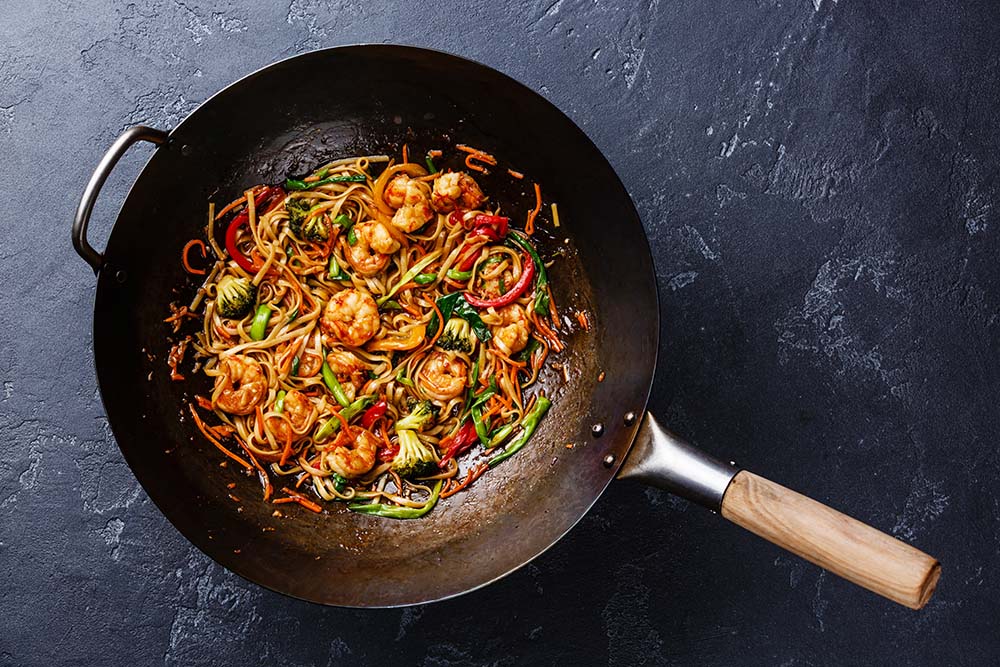
These two materials are widely popular across a range of culinary applications. Most of us are already familiar with cast iron skillets and use them frequently. Carbon steel features prominently in high end chef’s knives and many professional chef’s prefer carbon steel woks.
In the kitchen, these two metals sometimes fulfill similar purposes and with similar effects, and the materials themselves are not so different in many ways.
The key physical difference boils down to this: Carbon steel contains about 1% carbon, while cast iron ranges from 2 to 3%. This is a nitty-gritty detail, but it has a host of implications for cooks.
We’ll be comparing these materials across four main areas that we believe are the most important for deciding between cookware materials, and then see specifically what they mean for woks.
These four areas are weight, care, cooking experience, and durability.
Weight is important to consider because it’ll help determine both how easy storage is and how comfortable you’ll feel while using the wok itself.
Care is critical here because neither cast iron nor carbon steel wok are your average non stick pan and require their own particular care regimes to keep them performing as they should.
Cooking experience is the obvious factor. These two metals will behave differently when heated and change your cooking experience depending on what you are cooking. You need to pick the right one for your tastes.
And of course, durability, because we all want a pan that’ll last a lifetime, and some that might last even longer.
What is Carbon Steel
Carbon steel is defined as a steel with a carbon content of no higher than 2.0% percent, though usually it hovers around the 1% mark.
This is a technical attribute that you don’t necessarily need to delve into, but it helps differentiate carbon steel as opposed to other types of steel and iron. The metallurgical details here aren’t necessarily important, but understanding this difference will help us to decide between a cast iron or a carbon steel wok.
Weight and Storage of the different Woks
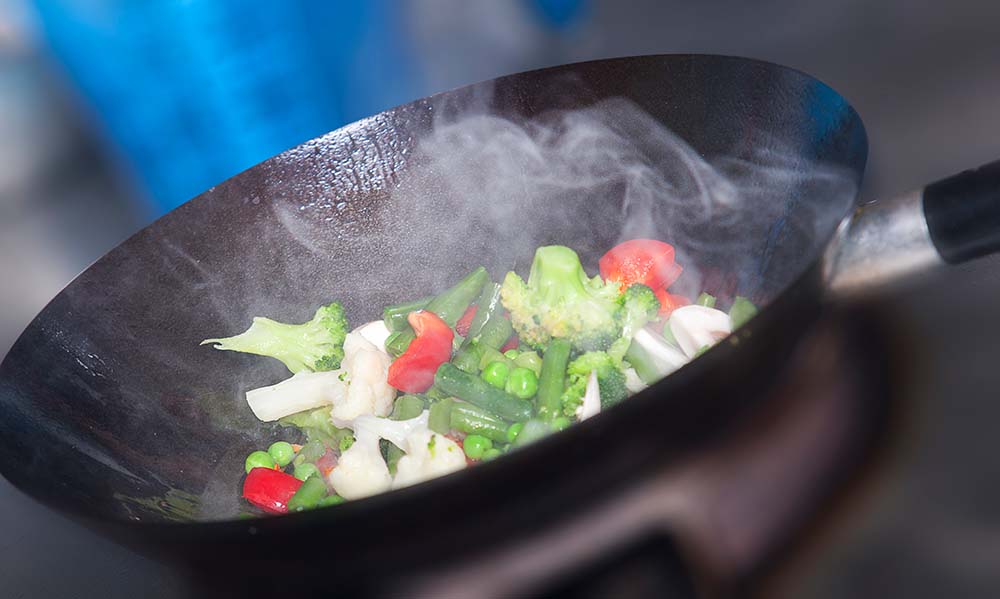
Weight of a carbon steel wok
This point about carbon leads right into our first factor, weight. Since carbon steel is extremely sturdy, it doesn’t take a lot of material to make a solid wok. Plus, the more carbon you add to a steel, the heavier it gets. Carbon steel woks will be on the very light side, with only aluminum coming in as lighter.
This makes it easy to lift and manipulate, and even easier to hoist up onto tall shelves or pot hooks. While cooking, you may also enjoy the feeling of a light pan and find it easier to control.
If you’re used to cooking on heavier pans, like say copper or, of course, cast iron, the extremely light weight may be off putting at first. However, it’s easy to adapt to and it might be a big bonus to you.
Weight of a cast iron wok
As we are all aware by now, cast iron cookware weighs quite a bit compared to other types of cookware materials. Cast iron woks also tend to be thicker and combined with the fact that higher carbon metals are heavier, as mentioned earlier, means that cast iron cookware can get quite thick. Woks are rather large pans, and cast iron woks are no exception.
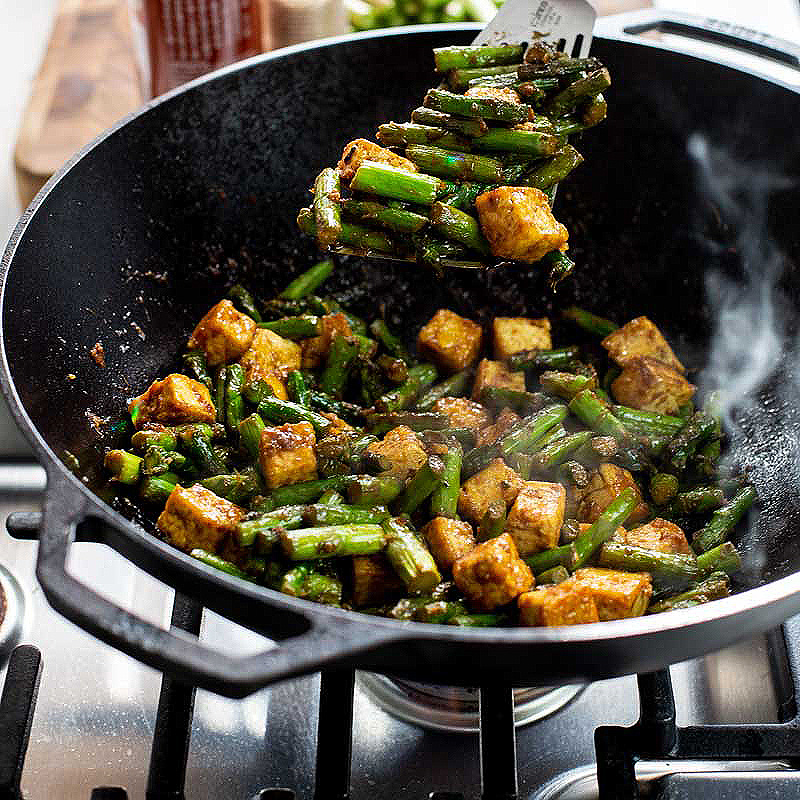
How to Care for Your Wok?
There are a few differences between the care of carbon steel and cast iron that we need to go over. And you’ll need to understand that the carbon steel works best when it’s used, and it will get dings and scratches.
How to care for Carbon Steel
Things start to get a touch complicated here. Carbon steel is a bit temperamental as a cookware material. If you decide to get a carbon steel wok, you should probably also learn how to take care of it and how it reacts to the environment.
Carbon steel is not stainless steel. The steel has not been alloyed with other metals to make it less reactive. This means that carbon steel is liable to change colors before, during, and after the cooking process.
Since carbon steel woks will be highly reactive, you might notice a patina develop. Sometimes you might get a truly stunning neon blue patina that shimmers in the light, but more often you’ll see brown streaks forming.
Not to worry, though. A patina, no matter the color, is always a great thing. A patina really just means that the surface of the metal is reacting to different things in the environment and it’s becoming less reactive. Patinas help protect from rust and prevent further reactions from occurring.
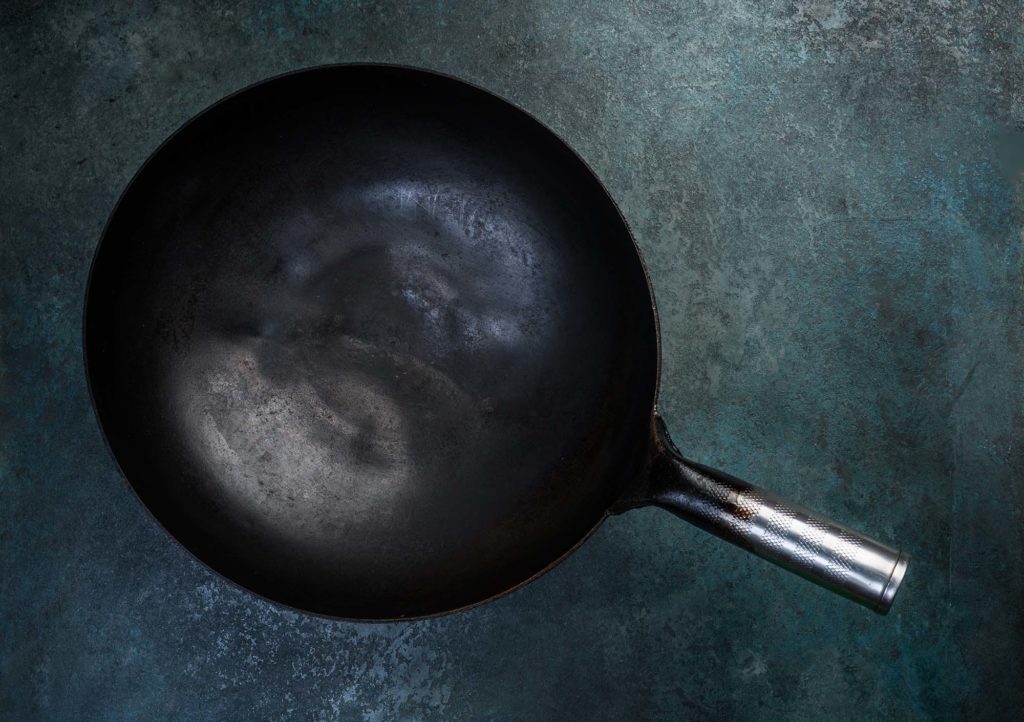
These reactions are most common when cooking highly acidic foods, so keep that in mind. Everything from citrus to wine to even tomatoes is likely to change the appearance of your carbon steel cookware.
But do be warned that leaving a carbon steel pan wet in storage will lead to rust formation! Always keep these pans dry when you aren’t using them.
The other critical part of carbon steel care is seasoning. Seasoning, like a patina, will also help prevent the formation of rust.
Carbon Steel Needs to be Seasoned
Most home cooks are familiar with the idea of seasoning these days because of the proliferation and popularity of cast iron. The idea is much the same for carbon steel.
Just make sure to hand-wash your carbon steel wok without soap, dry thoroughly with a towel, and apply oil after you clean and before you cook. As long as you keep that in mind, your pan will remain as non-stick as ever.
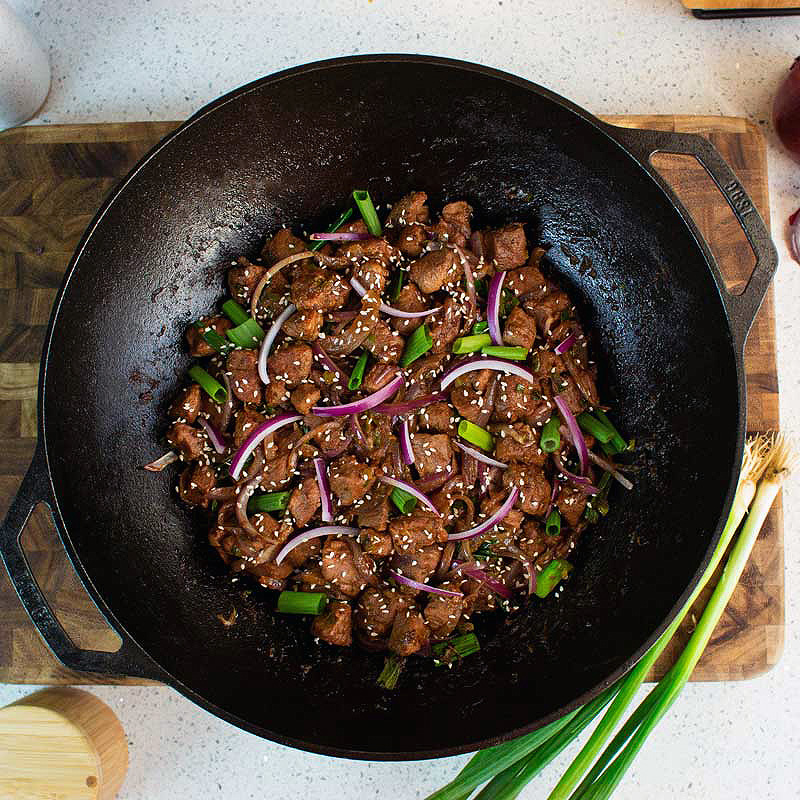
How to care for a cast iron wok
Like carbon steel, cast iron woks need their own specific care regime. These pans need to be seasoned with oil, fully dried, and never machine washed. If you already have a cast iron, you know the drill.
The one benefit here is that cast iron is less likely to react with acidic ingredients, though this is due in part because of the seasoning process. The acid will only come in contact with the seasoning so the metal will never react.
Just make sure to reason the pan frequently if you decide to put highly acidic ingredients into the cast iron pan.
Which wok is best for Chinese cooking?
Cooking with a Carbon Steel Wok
This is one of the realms that carbon steel really shines in. In fact, carbon steel woks are generally regarded as the favored go-to for professional chefs who cook Asian cuisine.
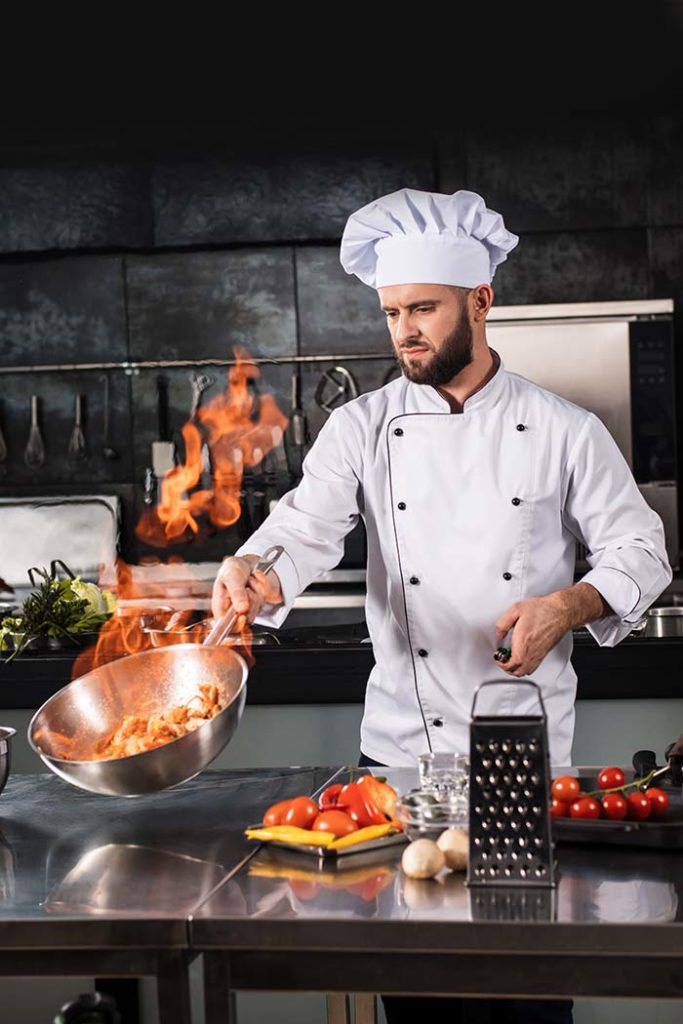
Cast iron and carbon steel have similar thermal conductivity rates. This just refers to the rate at which heat is transferred through a metal. However, in the real world the difference between cast iron and carbon steel is huge.
In practice, the difference boils down to the simple fact that carbon steel woks are just so much thinner than cast iron woks. Since carbon steel is less brittle and more durable than cast iron, not only is carbon steel cookware lighter, but they heat up quickly and lose heat just as quickly.
Is carbon steel best for a wok?
This is a great asset in the kitchen, and especially so for stir-frying on a wok. The pan gets hot super quick so you’ll be ready to go in no time, and if you notice your food is starting to burn all you need to do is turn off the heat and the temperature will instantly drop. Carbon steel woks give you truly excellent heat control.
Many Chinese chefs also claim that carbon steel woks are absolutely indispensable for utilizing the famed Bao technique to impart a unique and delicious smoky stir-fry flavor known as wok hei to the food.
Since a carbon steel wok heats up so quickly, and then can quickly lose its heat off the flames before the food burns, there is no better choice of metal for practicing traditional Chinese stir-frying techniques like Bao and wok hei.
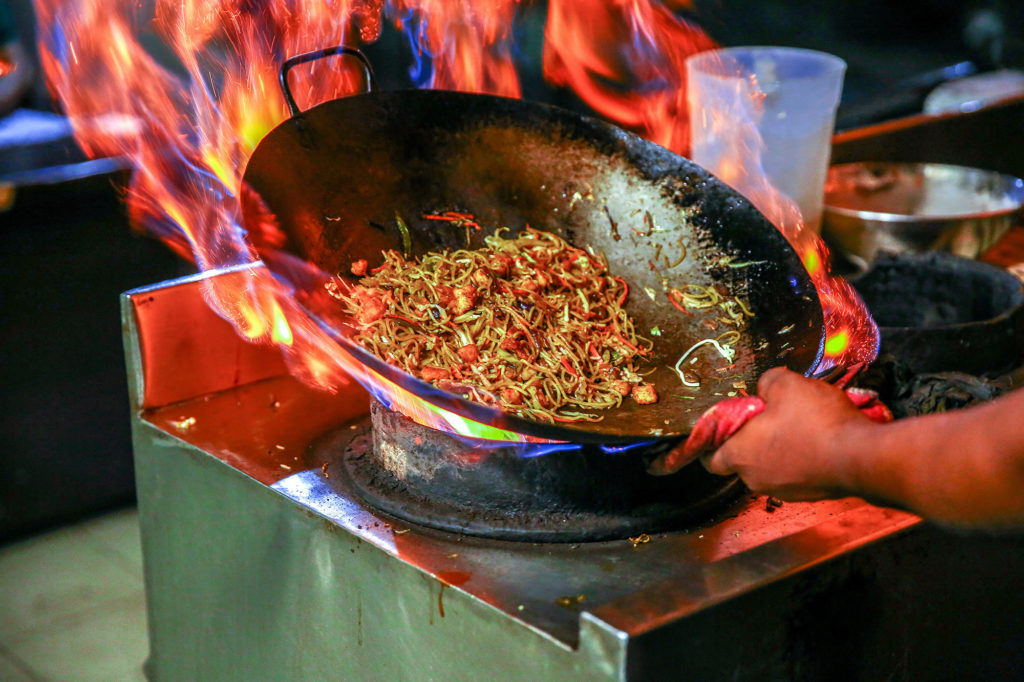
Cooking with a Cast Iron Wok
This is where cast iron diverges most clearly from carbon steel.
A cast iron wok will take longer to heat up, but also hold onto its high heat longer because of its thickness. This means that there won’t be a large temperature drop when you put food into the cast iron wok. Cast iron retains heat extremely well, and you’ll notice the difference when cooking.
This makes it excellent for searing, since it can maintain high temperatures. Remember though, you won’t have as high a level of heat control with a cast iron wok and just removing the wok off the heat source may not prevent the food from burning like with carbon steel.
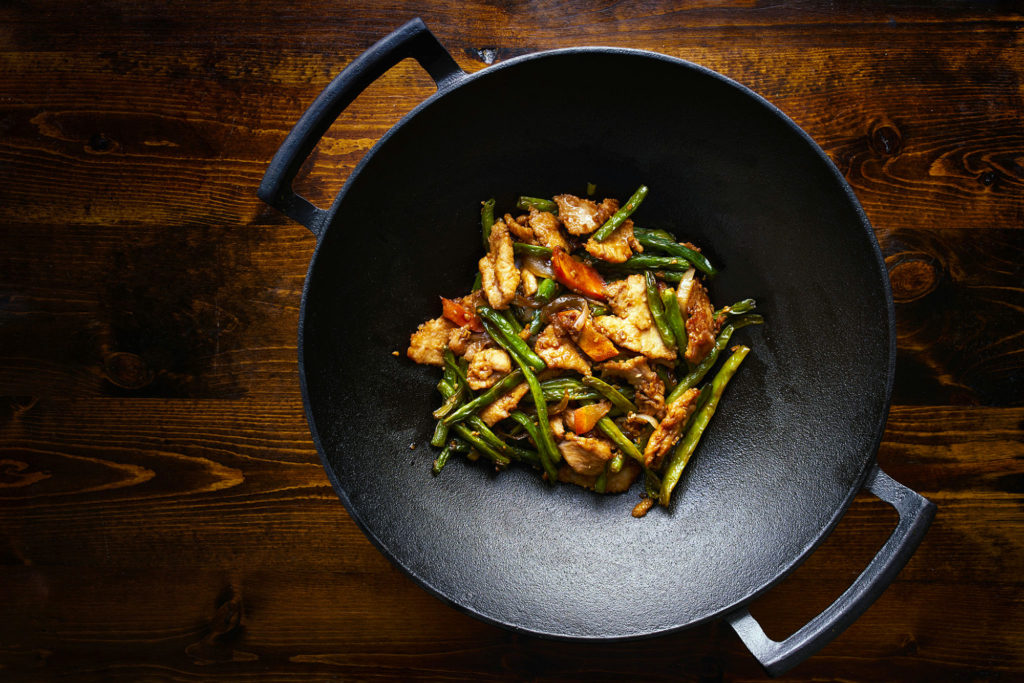
Also, since cast iron is so much thicker than carbon steel, it tends to be slightly worse at heat distribution. The thickness of the pan means that there is more room for variation across the pan, and the casting process does leave many tiny pockmarks in the cast iron. This is not something you’ll necessarily notice, but it depends on the pan and its construction.
Cast iron also is less likely to have a wooden handle, which makes it perfect for use in the oven as well.
Longevity of Carbon Steel vs Cast Iron
How long does a carbon steel wok last?
The durability of your cookware will always be an important question. It’s no fun having things break on you, to say nothing of losing a piece of cookware in the middle of frantically cooking for a ten-person party that starts in an hour. Many of us also deeply care about the connections we form around cooking and eating and expect to one day pass on our treasured tools to younger generations and keep the tradition alive.
Carbon steel goes two ways here.
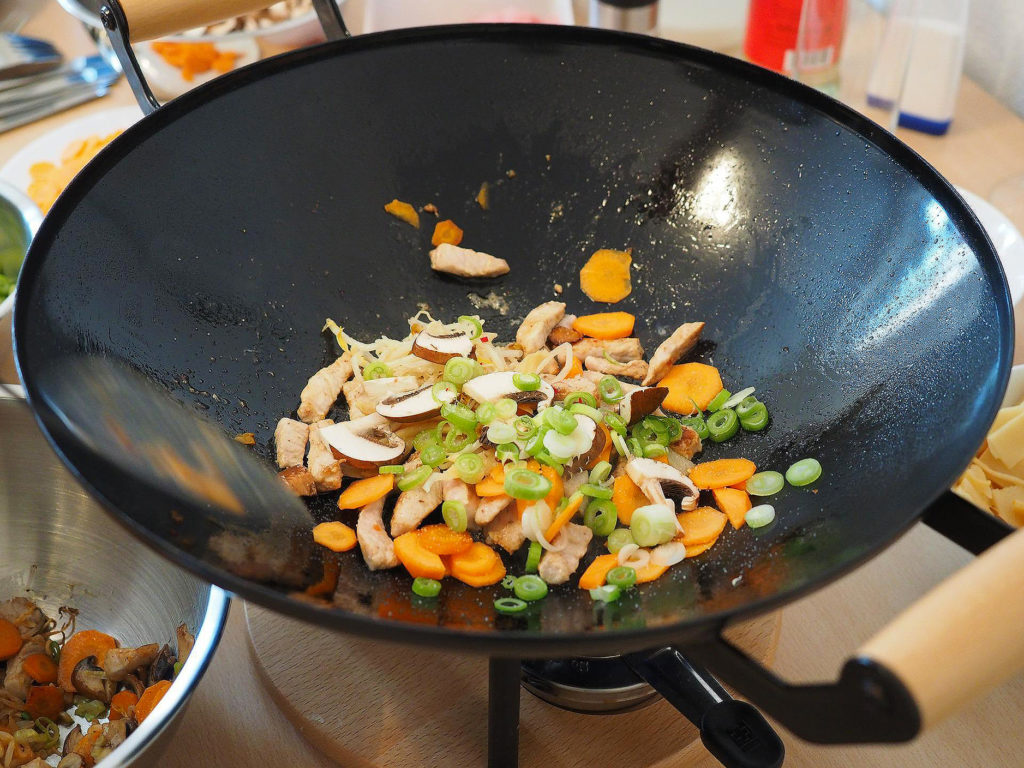
As mentioned earlier, carbon steel is very durable, and when cared for properly well protected against many of the most common enemies of metals, like rust.
That being said, a carbon steel wok will be particularly thin, so be aware that it is still possible to dent or warp if it gets dropped or otherwise mishandled.
But again, like with care, as long as you follow proper procedures, a carbon steel wok will last you a lifetime, if not generations.
How long does a cast iron wok last?
Obviously, cast iron woks are meant to last. And they do. They’re extremely long lasting pieces of equipment.
In theory, cast irons are prone to cracking and breaking. Since they have a higher carbon content than carbon steel, they are, on paper, more brittle.
This means that dropping a cast iron wok could potentially lead to the cookware being rendered completely unusable, though it’s more likely that your kitchen tiles suffer more under its weight.
So which is better, a cast iron wok or a carbon steel wok?
When it comes down to comparing a cast iron wok vs carbon steel wok, it depends, of course. As noted above, the two main differences are in weight and in cooking experience.
You’ll find that you can use many of the same cooking techniques in either. For example, both are equally good at deep frying and work as great all purpose frying pans.
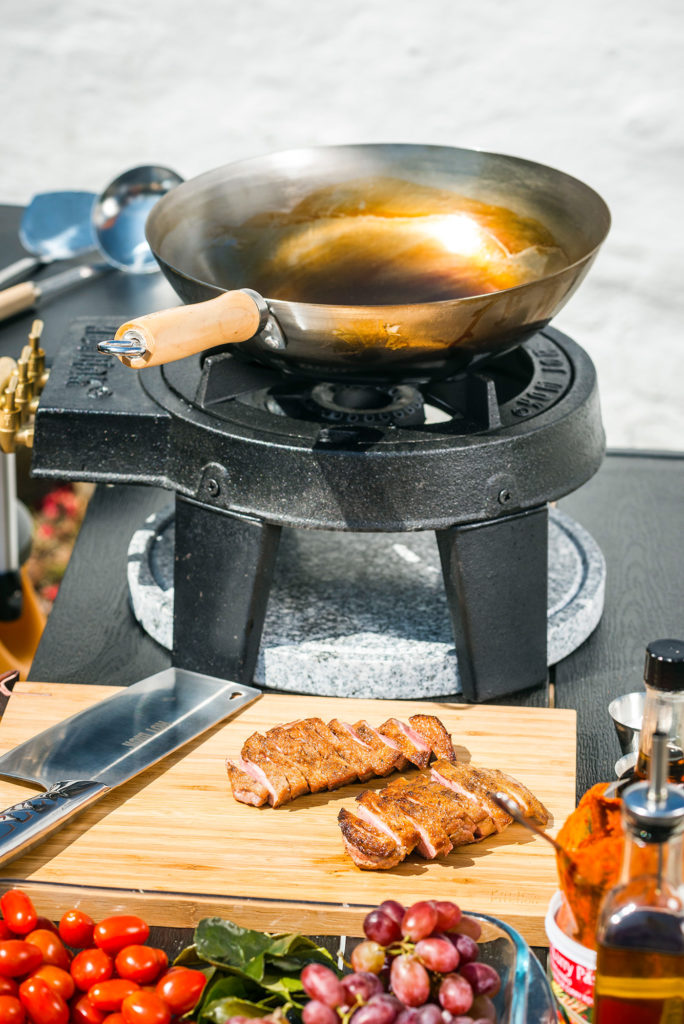
Pros and Cons of Cast Iron and Carbon Steel Woks
Both are easy to clean, as long as you follow the right procedures. Cast iron is very heavy, but will retain heat for a long time, making it excellent for searing. Carbon steel is light which makes it easier to maneuver and the thinness of the material will give you excellent heat control.
The pros and cons of carbon steel and cast iron have a lot of overlap at the end of the day, and in fact, they are similar materials in many ways. You’ll also find that both are completely compatible with either an electric stove or induction cooking surface.
There’s also one final consideration that I think is worth looking into. How much food are you looking to cook and serve? This will help you reach a final decision on cast iron or carbon steel if none of the other points sway you.
If it’s a lot of food, and you need to serve large meals, go with the cast iron. The heat retention will allow you to keep adding food to the pan and continue cooking it evenly.
If you only need to feed yourself or a few others, prefer small meals, or are ok with batch cooking, consider carbon steel instead. The wok will quickly heat up between batches so you can keep going.
I’ll leave you with a couple of great options
Here are two excellent wok options, one cast iron and one carbon steel. Here is a beautiful and functional hand hammered carbon steel wok that’s quite affordable as well.
And here we have a wonderfully utilitarian Lodge Cast Iron Wok that you can use on any type of cooking surface.
